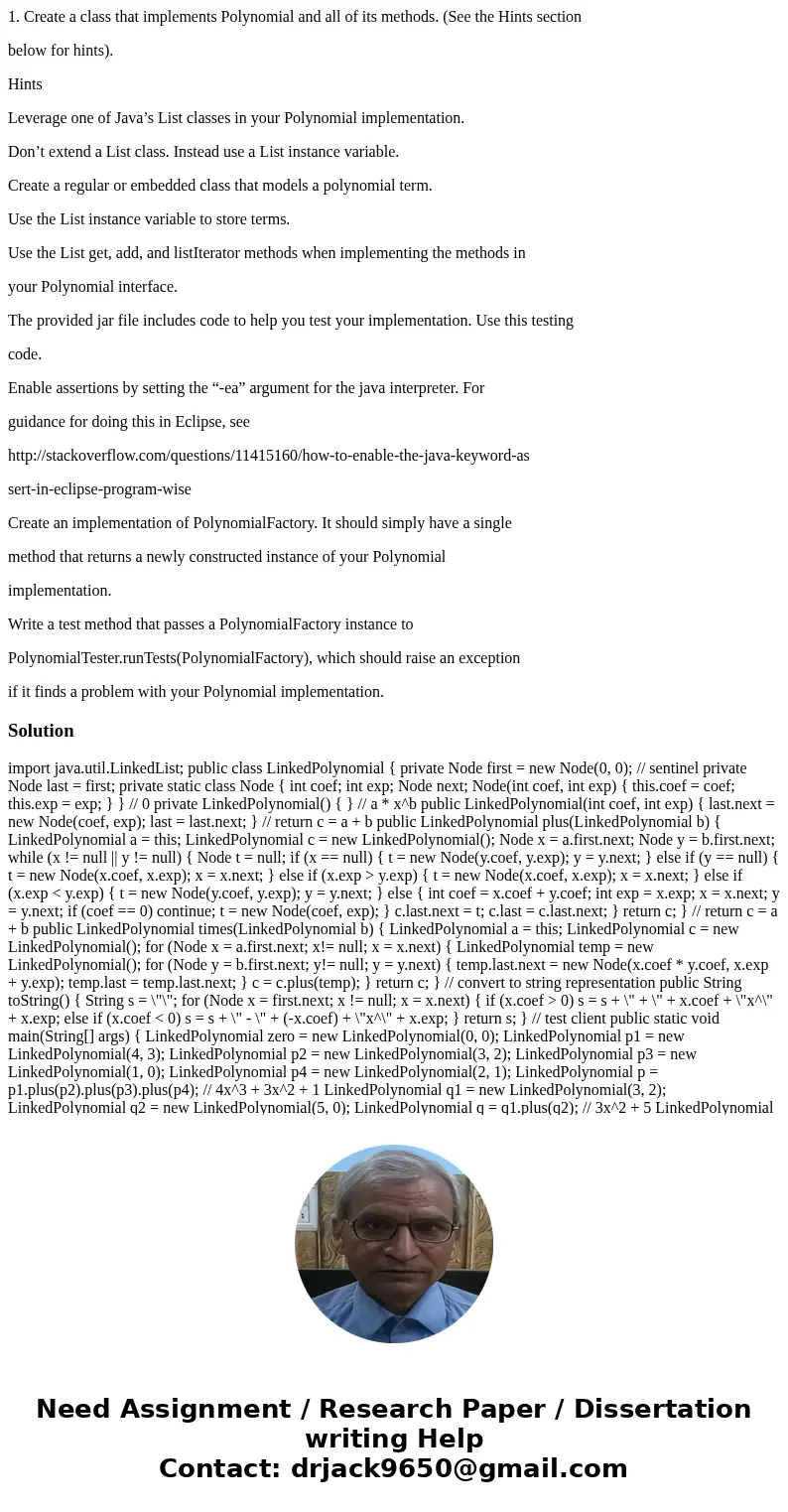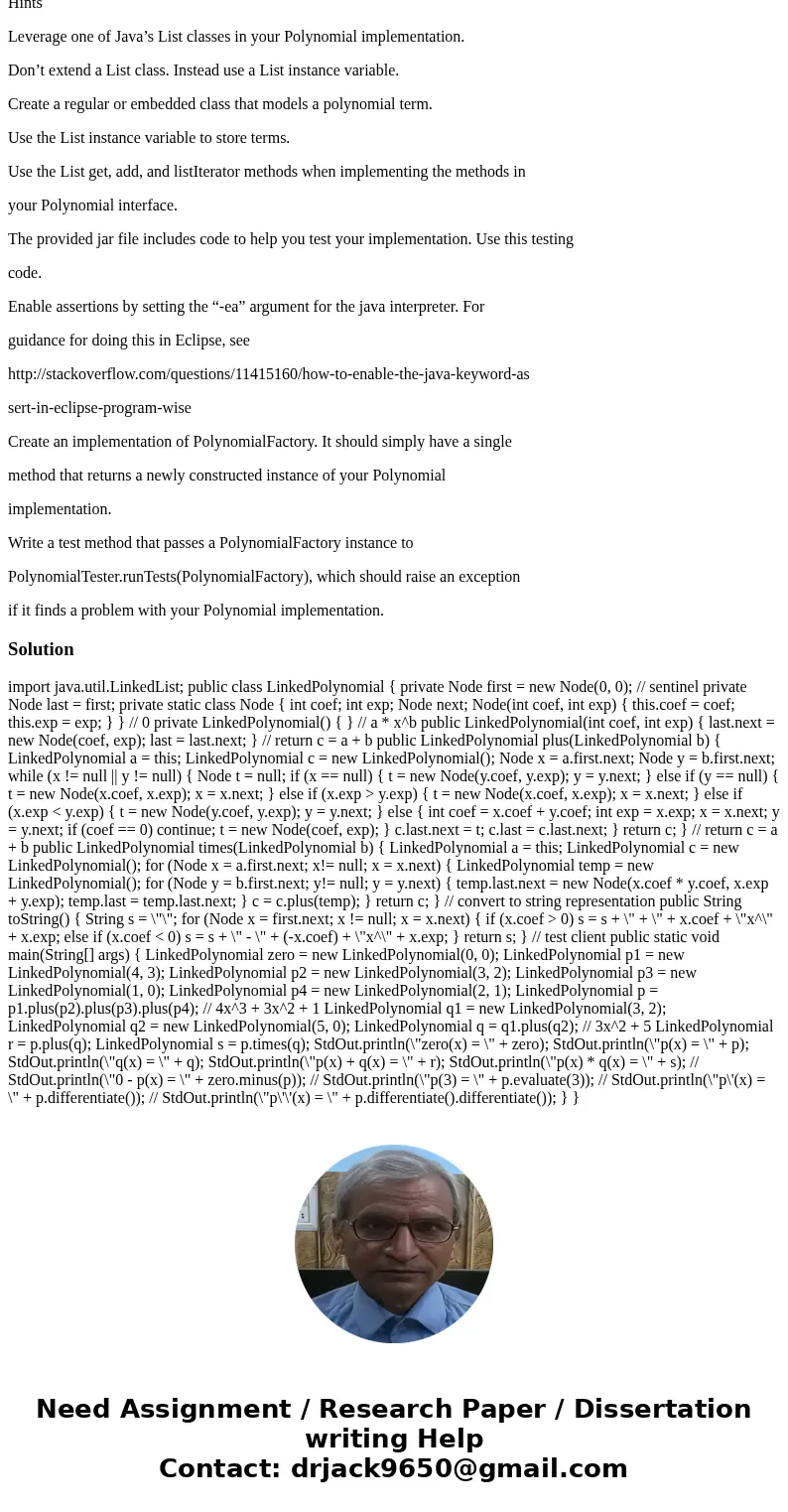1 Create a class that implements Polynomial and all of its m
1. Create a class that implements Polynomial and all of its methods. (See the Hints section
below for hints).
Hints
Leverage one of Java’s List classes in your Polynomial implementation.
Don’t extend a List class. Instead use a List instance variable.
Create a regular or embedded class that models a polynomial term.
Use the List instance variable to store terms.
Use the List get, add, and listIterator methods when implementing the methods in
your Polynomial interface.
The provided jar file includes code to help you test your implementation. Use this testing
code.
Enable assertions by setting the “-ea” argument for the java interpreter. For
guidance for doing this in Eclipse, see
http://stackoverflow.com/questions/11415160/how-to-enable-the-java-keyword-as
sert-in-eclipse-program-wise
Create an implementation of PolynomialFactory. It should simply have a single
method that returns a newly constructed instance of your Polynomial
implementation.
Write a test method that passes a PolynomialFactory instance to
PolynomialTester.runTests(PolynomialFactory), which should raise an exception
if it finds a problem with your Polynomial implementation.
Solution
import java.util.LinkedList; public class LinkedPolynomial { private Node first = new Node(0, 0); // sentinel private Node last = first; private static class Node { int coef; int exp; Node next; Node(int coef, int exp) { this.coef = coef; this.exp = exp; } } // 0 private LinkedPolynomial() { } // a * x^b public LinkedPolynomial(int coef, int exp) { last.next = new Node(coef, exp); last = last.next; } // return c = a + b public LinkedPolynomial plus(LinkedPolynomial b) { LinkedPolynomial a = this; LinkedPolynomial c = new LinkedPolynomial(); Node x = a.first.next; Node y = b.first.next; while (x != null || y != null) { Node t = null; if (x == null) { t = new Node(y.coef, y.exp); y = y.next; } else if (y == null) { t = new Node(x.coef, x.exp); x = x.next; } else if (x.exp > y.exp) { t = new Node(x.coef, x.exp); x = x.next; } else if (x.exp < y.exp) { t = new Node(y.coef, y.exp); y = y.next; } else { int coef = x.coef + y.coef; int exp = x.exp; x = x.next; y = y.next; if (coef == 0) continue; t = new Node(coef, exp); } c.last.next = t; c.last = c.last.next; } return c; } // return c = a + b public LinkedPolynomial times(LinkedPolynomial b) { LinkedPolynomial a = this; LinkedPolynomial c = new LinkedPolynomial(); for (Node x = a.first.next; x!= null; x = x.next) { LinkedPolynomial temp = new LinkedPolynomial(); for (Node y = b.first.next; y!= null; y = y.next) { temp.last.next = new Node(x.coef * y.coef, x.exp + y.exp); temp.last = temp.last.next; } c = c.plus(temp); } return c; } // convert to string representation public String toString() { String s = \"\"; for (Node x = first.next; x != null; x = x.next) { if (x.coef > 0) s = s + \" + \" + x.coef + \"x^\" + x.exp; else if (x.coef < 0) s = s + \" - \" + (-x.coef) + \"x^\" + x.exp; } return s; } // test client public static void main(String[] args) { LinkedPolynomial zero = new LinkedPolynomial(0, 0); LinkedPolynomial p1 = new LinkedPolynomial(4, 3); LinkedPolynomial p2 = new LinkedPolynomial(3, 2); LinkedPolynomial p3 = new LinkedPolynomial(1, 0); LinkedPolynomial p4 = new LinkedPolynomial(2, 1); LinkedPolynomial p = p1.plus(p2).plus(p3).plus(p4); // 4x^3 + 3x^2 + 1 LinkedPolynomial q1 = new LinkedPolynomial(3, 2); LinkedPolynomial q2 = new LinkedPolynomial(5, 0); LinkedPolynomial q = q1.plus(q2); // 3x^2 + 5 LinkedPolynomial r = p.plus(q); LinkedPolynomial s = p.times(q); StdOut.println(\"zero(x) = \" + zero); StdOut.println(\"p(x) = \" + p); StdOut.println(\"q(x) = \" + q); StdOut.println(\"p(x) + q(x) = \" + r); StdOut.println(\"p(x) * q(x) = \" + s); // StdOut.println(\"0 - p(x) = \" + zero.minus(p)); // StdOut.println(\"p(3) = \" + p.evaluate(3)); // StdOut.println(\"p\'(x) = \" + p.differentiate()); // StdOut.println(\"p\'\'(x) = \" + p.differentiate().differentiate()); } }

 Homework Sourse
Homework Sourse